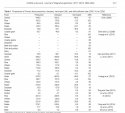A lot of the idle workers in the cities have already started moving back to the countryside a long time ago.
The Chinese government has also funded several secondary cities to relieve the population pressure in the primary cities.
Most of the development effort has gone there lately. Still there is plenty of evidence that larger cities lead to increased GDP/capita.
I doubt you will see the Chinese government totally abandon the development of the main cities.
China should IMHO improve its food, energy, and clean water/air sectors. To a large degree the government is doing this already.
Massive efforts into high-speed rail and electric vehicles.
The Chinese government has also funded several secondary cities to relieve the population pressure in the primary cities.
Most of the development effort has gone there lately. Still there is plenty of evidence that larger cities lead to increased GDP/capita.
I doubt you will see the Chinese government totally abandon the development of the main cities.
China should IMHO improve its food, energy, and clean water/air sectors. To a large degree the government is doing this already.
Massive efforts into high-speed rail and electric vehicles.

